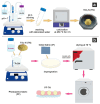Visible-Light-Driven Degradation of Biological Contaminants on the Surface of Textile Fabric Modified with TiO2-N Photocatalyst
- PMID: 40806682
- PMCID: PMC12347451
- DOI: 10.3390/ijms26157550
Visible-Light-Driven Degradation of Biological Contaminants on the Surface of Textile Fabric Modified with TiO2-N Photocatalyst
Abstract
The problem of spreading harmful infections through contaminated surfaces has become more acute during the recent coronavirus pandemic. The design of self-cleaning materials, which can continuously decompose biological contaminants, is an urgent task for environmental protection and human health care. In this study, the surface of blended cotton/polyester fabric was functionalized with N-doped TiO2 (TiO2-N) nanoparticles using titanium(IV) isopropoxide as a binder to form durable photoactive coating and additionally decorated with Cu species to promote its self-cleaning properties. The photocatalytic ability of the material with photoactive coating was investigated in oxidation of acetone vapor, degradation of deoxyribonucleic acid (DNA) fragments of various lengths, and inactivation of PA136 bacteriophage virus and Candida albicans fungi under visible light and ultraviolet A (UVA) radiation. The kinetic aspects of inactivation and degradation processes were studied using the methods of infrared (IR) spectroscopy, polymerase chain reaction (PCR), double-layer plaque assay, and ten-fold dilution. The results of experiments showed that the textile fabric modified with TiO2-N photocatalyst exhibited photoinduced self-cleaning properties and provided efficient degradation of all studied contaminants under exposure to both UVA and visible light. Additional modification of the material with Cu species substantially improved its self-cleaning properties, even in the absence of light.
Keywords: N-doped TiO2; photoactive fabric; photocatalytic degradation; self-cleaning textile; visible light.
Conflict of interest statement
The authors declare no conflicts of interest.
Figures








Similar articles
-
Mechanism of DNA and RNA degradation over a photoactive TiO2@SiO2-coated fabric.Int J Biol Macromol. 2025 Jul;318(Pt 2):145089. doi: 10.1016/j.ijbiomac.2025.145089. Epub 2025 Jun 8. Int J Biol Macromol. 2025. PMID: 40494472
-
Prescription of Controlled Substances: Benefits and Risks.2025 Jul 6. In: StatPearls [Internet]. Treasure Island (FL): StatPearls Publishing; 2025 Jan–. 2025 Jul 6. In: StatPearls [Internet]. Treasure Island (FL): StatPearls Publishing; 2025 Jan–. PMID: 30726003 Free Books & Documents.
-
Efficient nitrate reduction in water using an integrated photocatalyst adsorbent based on chitosan-titanium dioxide nanocomposite.Environ Sci Pollut Res Int. 2023 Mar;30(13):38014-38030. doi: 10.1007/s11356-022-24895-5. Epub 2022 Dec 28. Environ Sci Pollut Res Int. 2023. PMID: 36575259
-
Signs and symptoms to determine if a patient presenting in primary care or hospital outpatient settings has COVID-19.Cochrane Database Syst Rev. 2022 May 20;5(5):CD013665. doi: 10.1002/14651858.CD013665.pub3. Cochrane Database Syst Rev. 2022. PMID: 35593186 Free PMC article.
-
Management of urinary stones by experts in stone disease (ESD 2025).Arch Ital Urol Androl. 2025 Jun 30;97(2):14085. doi: 10.4081/aiua.2025.14085. Epub 2025 Jun 30. Arch Ital Urol Androl. 2025. PMID: 40583613 Review.
References
-
- Ganesh V.A., Raut H.K., Nair A.S., Ramakrishna S. A Review on Self-Cleaning Coatings. J. Mater. Chem. 2011;21:16304. doi: 10.1039/c1jm12523k. - DOI
-
- Ragesh P., Anand Ganesh V., Nair S.V., Nair A.S. A Review on ‘Self-Cleaning and Multifunctional Materials. J. Mater. Chem. A. 2014;2:14773–14797. doi: 10.1039/C4TA02542C. - DOI
Grants and funding
LinkOut - more resources
Full Text Sources

